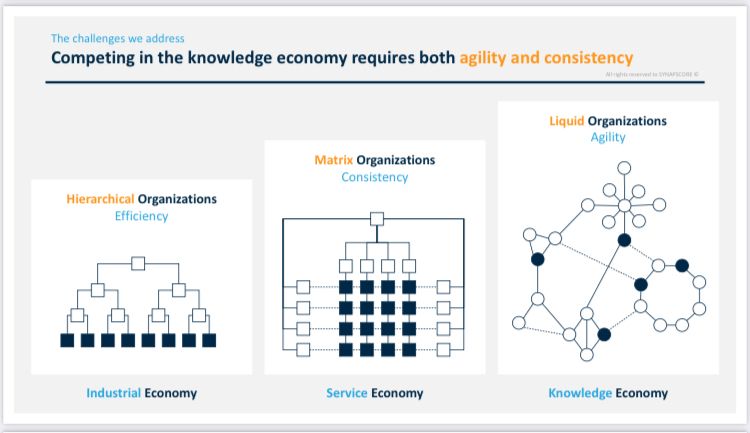The forces at work in the knowledge economy require a complete paradigm shift in the way organizations are thought of and managed. This revolution concerns all forms of organization.
The hierarchical organization has made the success of large industrial companies. Vertical structuring coupled with a high degree of task specialization has resulted in increased quality, optimized capacity utilization and reduced cycle times. The priority is then given to efficiency.
Industrial Economy:
– hierarchical organization
– tangible assets
– efficiency
The matrix organization has become the dominant model in the service economy. It has made it possible to combine proximity to the customer and the pooling of critical resources. This is the time of dual reporting (hierarchical and functional), shared service centers and cross-functional processes. Without losing efficiency, synergies are sought.
Service Economy:
– matrix organization
– intangible assets
– synergies
The knowledge economy has been imposed with the digital revolution. Today, companies must maintain their efficiency and optimize synergies, but they must also and above all be agile to detect and seize opportunities quickly. Collective intelligence becomes the key asset.
Knowledge Economy:
– liquid organization
– digital assets
– agility
Each organizational model has its own management by objectives system:
– Hoshin Kanri: industrial organization
– Balanced Scorecard: matrix organization
– Objectives & Key Results: liquid organization
We speak of a new paradigm when we profoundly change the ideas and words used to analyze and optimize a system. The new paradigm must retain the advantages of the previous one while meeting new and radically different requirements.
Wanting to use a management system that was designed for a matrix operation cannot work with a liquid organization. Today, it is anachronistic to want to be agile while driving the strategy with goal cards.
When there is a disjunction between the forces of the economy, the organizational model and the management system, the company is not only unable to respond to new challenges (agility) but it ends up losing what made it strong:
– Synergies disappear.
– Efficiency collapses.
– Employees are confused.
– Psychosocial risks are exploding.
– The best talents leave.
– Companies are disappearing.
Changing the paradigm is very difficult because it requires a change in vision, culture, values, behaviors, processes and tools.
Few leaders are aware of this and even fewer are capable of it. Creative destruction does the sorting.


0 Comments